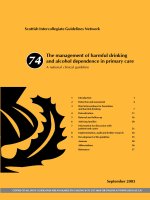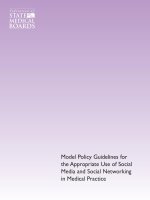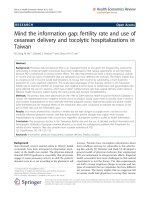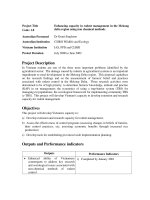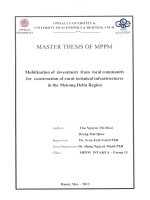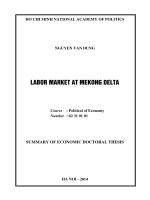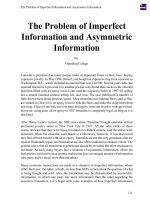the acceptance of electronic word of mouth information and brand trust in the tourism sector in the mekong delta region
Bạn đang xem bản rút gọn của tài liệu. Xem và tải ngay bản đầy đủ của tài liệu tại đây (3.86 MB, 35 trang )
<span class="text_page_counter">Trang 1</span><div class="page_container" data-page="1">
Can Tho, 03/2024
</div><span class="text_page_counter">Trang 2</span><div class="page_container" data-page="2">2
TABLE OF CONTENTS
I.INTRODUCTION ... 3
II.THEORETICAL BASIS AND RESEARCH HYPOTHESIS ... 4
1.Electronic word of mouth ... 4
2.Acceptance of information ... 5
3.Brand image ... 6
4.Brand trust ... 7
5.Relationship between e-WOM Acceptance and Brand Image and Trust .... 7
III. RESEARCH METHODOLOGY ... 8
IV.RESEARCH RESULTS ... 9
1.Sample description ... 9
2.Scale testing ...11
2.1.Reliability test conducted by Cronbach’s alpha indicator ...11
2.2.Validity ...17
2.3.Affirmative Factor Analysis (CFA) ...17
3.Structural Equation Modeling (SEM) ...25
4.Discuss Results ...26
V.CONCLUSIONS ...31
VI.REFERENCE ...33
</div><span class="text_page_counter">Trang 3</span><div class="page_container" data-page="3">3
THE ACCEPTANCE OF ELECTRONIC WORD-OFMOUTH INFORMATION AND BRAND TRUST IN THE TOURISM SECTOR IN THE MEKONG DELTA REGION
-ABTRACT
Based on the theories of information reception and branding, this study investigates the factors affecting the level of electronic word-of-mouth (e-WOM) reception and the correlation between this reception and brand image and trust. Data was collected from 108 respondents in the Mekong Delta region of Vietnam. The results of the study show that three main factors affect the level of e-WOM reception: relevance, accuracy, and source credibility. Positive reception of e-WOM leads to improved brand image and increased trust in the recommended brand. Additionally, the study also highlights the important role of brand image as a mediating variable in the relationship between e-WOM reception and brand trust.
Keywords: Electronic word of mouth; the acceptance of information; brand image; brand trust; tourism in the Mekong Delta.
I. INTRODUCTION
Entering the era of the 4.0 technological revolution, the world is witnessing significant changes in technology and digital endeavors. Interpersonal influence has garnered considerable attention in social psychology, with abundant evidence supporting the relevance of interpersonal communication in various decision-making contexts, including consumption (Katz and Lazarsfeld, 1955). Nowadays, the emergence of online platforms is gradually modernizing our communication methods. A notable advancement in this regard is the advent of Electronic Word-of-Mouth (eWOM). Studies have demonstrated that WOM communication holds more sway than communication through other channels such as editorial recommendations or advertisements (e.g., Bickart and Schindler, 2001; Smith et al., 2005; Trusov et al., 2009) due to its perceived reliability (Gruen et al., 2006). Consequently, eWOM is deemed highly persuasive, attributed to its perceived credibility and trustworthiness (e.g., Chatterjee, 2001; Godes and Mayzlin, 2004; Mayzlin, 2006). By establishing credibility through electronic word-of-mouth, the information received adds significant value to consumer awareness and greatly influences consumer attitudes and purchase
</div><span class="text_page_counter">Trang 4</span><div class="page_container" data-page="4">4
intentions. Currently, the role of eWOM in the tourism industry, particularly in the Mekong Delta region, is being emphasized. In large part, tourists are influenced by information gathered through electronic word-of-mouth when deciding whether to travel to the Mekong Delta region or not. A prerequisite for this decision is brand trust, which directly impacts tourists' destination choices. They tend to choose travel brands they trust in terms of service quality and experience provided. The Mekong Delta, with its diverse Vietnamese cultural identity and abundant natural resources, has become a potential tourism development hub. In 2018, the Mekong Delta welcomed over 40 million tourists, a 16.8% increase from 2017, including over 3 million international visitors. By 2019, the region hosted 47 million tourists, with an estimated 13.5 million overnight stays and total tourism revenue reaching an estimated 30 trillion Vietnamese dong. These figures indicate a significant influx of tourists to the region; however, the proportion of international visitors remains low compared to the total number of tourists, and revenue per visitor is also low. (Mai N. (2020, May 22). "How to develop tourism in the Mekong Delta? Vietnam Electronic Law Newspaper.) Based on the above, the team has chosen the topic "Acceptance of Electronic Word-of-Mouth Information and Brand Trust in the Tourism Sector in the Mekong Delta" with the aim of clarifying the factors influencing tourists' acceptance of eWOM information, evaluating the relationship between eWOM information acceptance and brand trust, and proposing solutions to enhance the acceptance of eWOM information and brand trust for tourism businesses in the Mekong Delta region. By employing survey methods and identifying appropriate variables to enhance brand trust in the tourism sector in the Mekong Delta region.
II. THEORETICAL BASIS AND RESEARCH HYPOTHESIS 1. Electronic word of mouth
Among the concepts previously proposed by scholars, WOM is the exchange of information about brands, products, or services between the receiver and the communicator (Anderson, 1998). WOM can occur through online or offline channels, but according to Keller (2007) and Keller and Fay (2009), offline channels dominate WOM - up to 90% in some cases. e-WoM is formed when WOM communications are brought onto the Internet through virtual platforms. The Internet is the main factor that distinguishes it from traditional WOM. Lee and Cranage (2014) emphasize this difference and argue that the impact of the Internet on WOM is significant. According to them, negative evaluations can quickly spread and cause negative changes for companies; conversely,
</div><span class="text_page_counter">Trang 5</span><div class="page_container" data-page="5">5
positive evaluations will attract more customers to businesses. Goldsmith's (2008) concept that "This new form of word-of-mouth (WOM) communication can contain positive or negative statements made by potential, actual, and former customers about a product or a company via the Internet" aligns with the research theme among the ideas proposed by previous scholars. Therefore, in this study, electronic word-of-mouth is defined as consumer evaluations and comments about items on online shopping platforms.
2. Acceptance of information
Research on online communication (Chen et al., 2011; Cheung et al., 2008; Li, 2013) often employs the Information Acceptance Model (IAM) introduced by Sussman and Siegal in 2003. The authors argue that the receiver must first assess the usefulness of the information. Customer information acceptance will also be influenced by subsequent sources of information. When studying eWOM, IAM is highly regarded by many scholars for its applicability (Cheung et al., 2008; Shu & Scott, 2014). Specifically, the IAM model has been used for studying behavior on online discussion forums by (Cheung et al., 2008). On the other hand, Shu & Scott (2014) applied it to social media contexts. Building upon the IAM model (Sussman and Siegal, 2003), Cheung et al. (2008) assert that relevance, timeliness, accuracy, and completeness are the quality factors of IAM information. Because this study focuses on eWOM in the social media context, IAM is considered suitable for use. The components of IAM used in this study are similar to those in the original model by Sussman and Siegal (2003).
Relevance: e-WOM information in online communities must be relevant to the website's theme as well as the products offered by the company because online consumers always want quick access to the information they need. According to Citroen (2011), the relevance of information is an important part of information usage decisions. Therefore, the first hypothesis is proposed: Q1: Consumers perceive that the higher the relevance of e-WOM information to their personal information needs, the higher their acceptance of e-WOM information will be.
Timeliness of the message is demonstrated through its currentness, timeliness, and updates. According to Chen & Popovich (2003), maintaining updated and consistent information on the web is crucial for effective communication and adding value to users. They emphasize that message accuracy lies in its ubiquity, relevance, and frequent updates, ensuring alignment with business operations. Moreover, customers will assess information as useful when they receive
</div><span class="text_page_counter">Trang 6</span><div class="page_container" data-page="6">Completeness is demonstrated through the message's thoroughness, integrity, and clarity of expression. According to Rygielski, Wang, and Yen (2002), websites targeting a broader audience will provide more detailed and diverse information. This is because these websites aim to attract customer attention and leverage their information. Cheung & et al. (2008) observed that messages containing more information and meeting readers' needs are more easily accepted. Therefore, we can formulate the fourth hypothesis as follows:
Q4: Consumers perceive that the higher the completeness of e-WOM information, the higher their acceptance of e-WOM information will be.
Trustworthiness of the source: Since users can express their opinions online without revealing their identities, readers will determine the credibility of this information. Readers will value information if they believe these opinions come from a trustworthy source (Cheung et al., 2008). Therefore, the fifth hypothesis is developed as follows:
Q5: Consumers perceive that the higher the trustworthiness of the e-WOM source, the higher their acceptance of e-WOM information will be.
3. Brand image
In marketing and brand building, brand image is considered a crucial concept (Zhang, 2015). According to Keller (1993, p.3), "brand image is the consumer's perception of the brand, reflecting the emotional associations, attitudes, and perceptions of brand quality in their minds." This perception process deciphers brand-related information. According to Nandan (2005),
</div><span class="text_page_counter">Trang 7</span><div class="page_container" data-page="7">7
marketing efforts to create a strong, favorably viewed brand with unique brand associations will form a positive brand image. Because the brand plays a significant role in supporting business activities, every business strives to build a strong brand image.
4. Brand trust
In the business world, brand trust plays a crucial role as it allows customers to connect with the idea of quality (Qu, Kim & Im, 2011) and develop loyalty to the brand (Kim, Han & Park, 2001). Therefore, establishing and nurturing long-term relationships with customers becomes essential for the long-term survival of the brand. According to Ha & Perks (2005), they define brand trust in the online context as a mental state associated with confidence and optimistic expectations from that specific brand. If a business demonstrates that its brand meets customer expectations, they can build trust with customers (Delgado-Ballester & Munuera-Alemán, 2001). Alongside these expectations are the risks that customers must accept, referred to as uncertainty. Creating an environment where customers perceive uncertainty as low will increase their trust in the brand (Erdem, Swait & Louviere, 2002).
5. Relationship between e-WOM Acceptance and Brand Image and Trust
Information acceptance is the process by which an individual intentionally uses that information (Cheung et al., 2008). Acceptance of eWOM is based on social norms or opinions in the online community. Information recipients establish eWOM trust during evaluation. If consumers perceive a review/comment as credible and useful, they will accept the information and gain confidence to use eWOM before making purchase decisions (Sussman & Siegel, 2003). In Samuel & Lianto's (2014) study, there was a positive relationship between electronic word-of-mouth and brand image. When tourists visit a destination, they seek information related to that destination. Additionally, Esch et al. (2006) affirmed the direct impact of brand image on consumer brand trust, specifically the positive impact of brand image on increasing brand trust.
The arguments above form the basis for eWOM's influence on brand image, and brand image acts as a mediating factor in the relationship between eWOM and brand trust. Two hypotheses, Q6 and Q7, are proposed as follows:
Q6: Consumers with higher acceptance of e-WOM will perceive a more positive proposed brand image.
</div><span class="text_page_counter">Trang 8</span><div class="page_container" data-page="8">Q8: Consumers with higher acceptance of e-WOM will have higher levels of trust in the proposed brand.
III. RESEARCH METHODOLOGY
A scientific research method using a 5-level Likert scale (1 - completely disagree, 5 - completely agree) was developed and developed based on the foundation of many previous studies, including those of Citrin (2001), Wixom & Todd (2005), Wu & Shaffer (1987), Bambauer Sachse & Mangold (2011), Davis & colleagues (2009), and Delgado-Ballester & Munuera Alemán (2001). As a result of this process, 32 observational variables representing eight concepts in the study were identified. Subsequently, a large number of tourists (108 individuals) from the local population in Can Tho city participated in the data collection process by completing survey questionnaires. The data collection result was 108 response sheets. To ensure the reliability of the scale, Cronbach's Alpha tool was used to test and evaluate the internal reliability of the scale. Convergence and
</div><span class="text_page_counter">Trang 9</span><div class="page_container" data-page="9">9
discrimination of variables were examined through EFA (Exploratory Factor Analysis) and CFA (Confirmatory Factor Analysis). Finally, research hypotheses were tested through a linear structural model, allowing for the evaluation of relationships between observational variables. IV. RESEARCH RESULTS
1. Sample description
Among a total of 108 respondents, males accounted for 44.4%, females accounted for 54.6%, and others accounted for 1%. The majority of respondents were in the age group of 18-25 (96.3%), with respondents in the age groups of 26-35 and 36-45 each accounting for 1.9%. Up to 87% of respondents had a university education, 11.1% had a college education, and postgraduate respondents accounted for 1.9%. The majority of respondents were students, accounting for 88%, while the remaining respondents were office workers (1.9%) and business/trading professionals (2.8%), with other occupations accounting for 7.4%. Only 2.8% of respondents had incomes above 20 million VND, while the remaining 86.1% had incomes below 10 million VND, and 11.1% had incomes of 10-20 million VND. Most respondents used the Internet extensively, with up to 90.7% of respondents using the Internet for over 45 minutes per day, 5.6% using it for 10-20 minutes per day, 2.8% using it for 21-30 minutes per day, and only 0.9% using it for 31-45 minutes per day. The two most used forms of e-WOM by respondents were instant messaging and travel news websites. Detailed statistics on sample characteristics are presented in Table 1.
</div><span class="text_page_counter">Trang 10</span><div class="page_container" data-page="10">10
Table 1.STT CRITERIA
TITY
RATE (%)
</div><span class="text_page_counter">Trang 11</span><div class="page_container" data-page="11">11
2. Scale testing2.1. Reliability test conducted by Cronbach’s alpha indicator
Performing Cronbach's Alpha analysis for the MD scale. The evaluation results show that the Cronbach's Alpha reliability coefficient of the MD scale is 0.898 (greater than 0.6), and all observational variables have statistically significant correlations with the total (Corrected Item - Total Correlation) greater than 0.3. Thus, the scale demonstrates good reliability, and the observational variables effectively explain the MD factor.
e-Virtual community 1.59
Instant messages 1.60
Website evaluating travel services 1.53
Travel News Website 1.60
</div><span class="text_page_counter">Trang 12</span><div class="page_container" data-page="12">12
Performing Cronbach's Alpha analysis for the DL scale similar to the MD scale, the evaluation results show that the Cronbach's Alpha reliability coefficient of the DL scale is 0.855 (greater than 0.6), and all observational variables have statistically significant correlations with the total (Corrected Item - Total Correlation) greater than 0.3. Thus, the scale demonstrates good reliability, and the observational variables effectively explain the DL factor.
</div><span class="text_page_counter">Trang 13</span><div class="page_container" data-page="13">13
Performing Cronbach's Alpha analysis for the CX scale similar to the MD scale, the evaluation results show that the Cronbach's Alpha reliability coefficient of the CX scale is 0.917 (greater than 0.6), and all observational variables have statistically significant correlations with the total (Corrected Item - Total Correlation) greater than 0.3. Thus, the scale demonstrates good reliability, and the observational variables effectively explain the CX factor.
Performing a Cronbach's Alpha analysis for the DD scale similar to the MD scale, the evaluation results showed that the Cronbach's Alpha reliability coefficient of the DD scale was 0.871 (greater than 0.6), and all observed variables had a statistically significant correlation with a total correlation greater than 0.3. Thus, the scale demonstrates good reliability, and observed variables effectively explain the DD factor.
</div><span class="text_page_counter">Trang 14</span><div class="page_container" data-page="14">14
Performing a Cronbach's Alpha analysis for the TN scale similar to the MD scale, the evaluation results showed that the Cronbach's Alpha reliability coefficient of the TN scale was 0.876 (greater than 0.6), and all observed variables had a statistically significant correlation with a total correlation greater than 0.3. Thus, the scale demonstrates good reliability, and observed variables effectively explain the TN factor.
</div><span class="text_page_counter">Trang 15</span><div class="page_container" data-page="15">15
Performing a Cronbach's Alpha analysis for the EW scale similar to the MD scale, the evaluation results showed that the Cronbach's Alpha reliability coefficient of the EW scale was 0.898 (greater than 0.6), and all observed variables had a statistically significant correlation with a total correlation greater than 0.3. Thus, the scale demonstrates good reliability, and observed variables effectively explain the EW factor.
Performing a Cronbach's Alpha analysis for the HA scale similar to the MD scale, the evaluation results showed that the Cronbach's Alpha reliability coefficient of the HA scale was 0.836 (greater than 0.6), and all observed variables had a statistically significant correlation with a total correlation greater than 0.3. Thus, the scale demonstrates good reliability, and observed variables effectively explain the HA factor.
</div><span class="text_page_counter">Trang 16</span><div class="page_container" data-page="16">16
Finally, performing a Cronbach's Alpha analysis for the NT scale similar to the MD scale, the evaluation results showed that the Cronbach's Alpha reliability coefficient of the NT scale was 0.912 (greater than 0.6), and all observed variables had a statistically significant correlation with a total correlation greater than 0.3. Thus, the scale demonstrates good reliability, and observed variables effectively explain the NT factor.
</div><span class="text_page_counter">Trang 17</span><div class="page_container" data-page="17">17
2.2. ValidityThe reliability of the scale falls within the range of 0.836 to 0.917, meeting the criterion of being greater than 0.6 (Nguyen Dinh Tho, 2014), ensuring the reliability of the scale. The results of the first EFA analysis show a Kaiser-Meyer-Olkin (KMO) measure of sampling adequacy of 0.940 (> 0.5), and a significant Bartlett’s Test of sphericity with a p-value of 0.000 (< 0.05), indicating that the exploratory factor analysis (EFA) is appropriate. The EFA results identified three factors formed from 32 observed variables extracted, with eigenvalues greater than 1 and a total cumulative variance of 68.843% (> 50%), and there were no changes in the observed variables compared to the original concept.
2.3. Affirmative Factor Analysis (CFA)
Table 2: Reliability test results and factor analysis
Observation variables <sup>Extraction </sup>variance <sup>√AVE </sup>
Cronbach's
Alpha <sup>CFA EFA </sup>Relevance (Citrin, 2001 0,587 0.898
MD1 The information from e-WoM is relevant to my information need 1 0.747
MD2 <sup>I found that there was a match between the information that e-W</sup>
provided and my information needs. <sup>0.92 0.745 </sup>
MD3 <sup>The information from e-WoM can be used to answer my questio</sup>
about certain travel issues. <sup>1.04 0.803 </sup>
</div>
